A Study on the Impact of Social Networks on Adolescent Mental Health
VerifiedAdded on 2022/09/26
|23
|6245
|28
Report
AI Summary
This report investigates the impact of social networks on adolescent mental health, aligning with WHO recommendations. It explores the increasing use of social media and its effects on teenagers, focusing on anxiety, depression, and self-esteem. The study examines the relationship between social media use and mental health, highlighting the need for policy integration. It reviews key studies and discusses implications for social work practice, emphasizing the role of social workers in addressing mental health issues. The report also provides background information on the rise of social media platforms and their association with psychiatric disorders, emphasizing the need for holistic approaches to mitigate risks. The study's findings aim to inform policy decisions and improve adolescent mental health management. The report also highlights the lack of awareness regarding the impact of social media on mental health and the need for intervention programs.
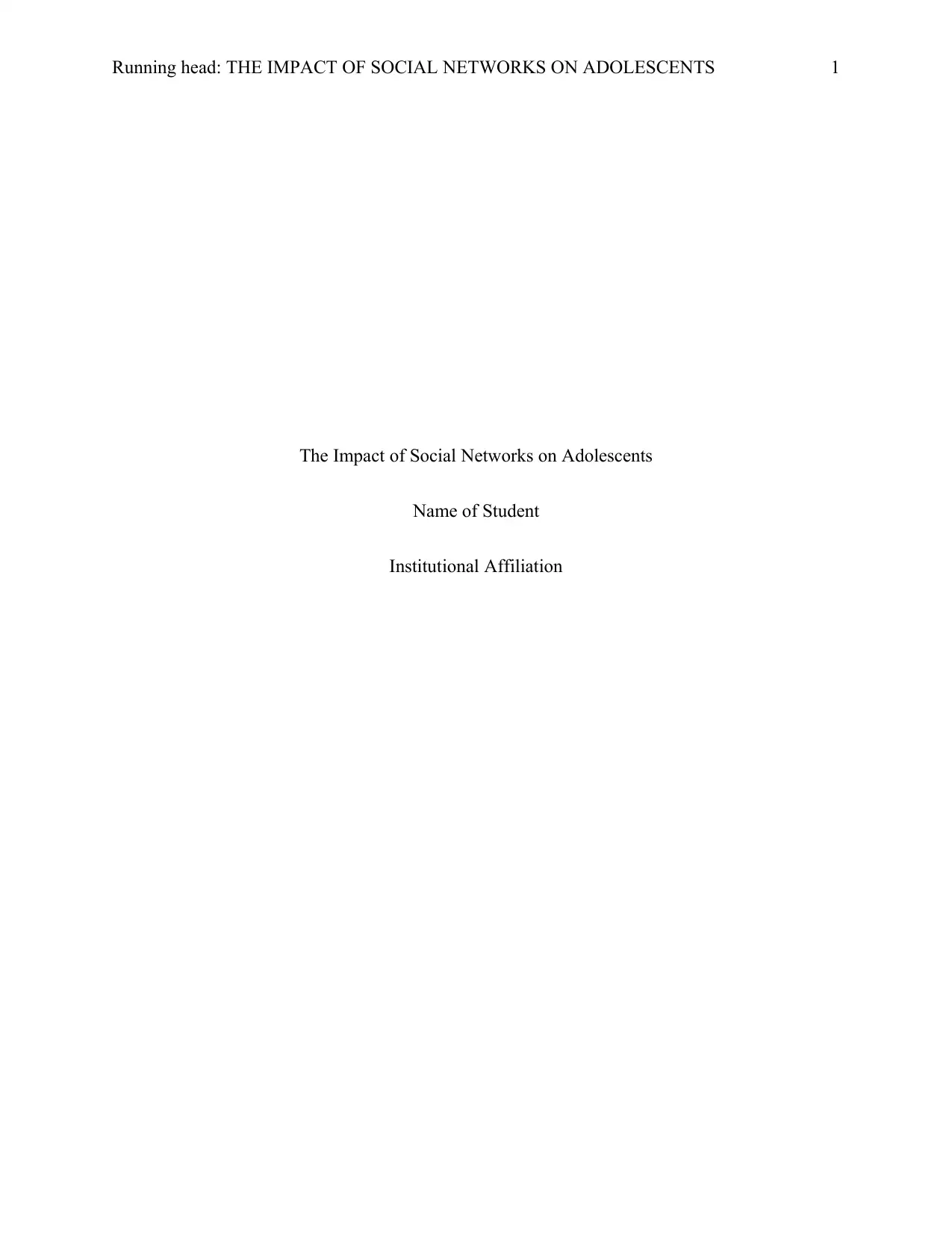
Running head: THE IMPACT OF SOCIAL NETWORKS ON ADOLESCENTS 1
The Impact of Social Networks on Adolescents
Name of Student
Institutional Affiliation
The Impact of Social Networks on Adolescents
Name of Student
Institutional Affiliation
Paraphrase This Document
Need a fresh take? Get an instant paraphrase of this document with our AI Paraphraser
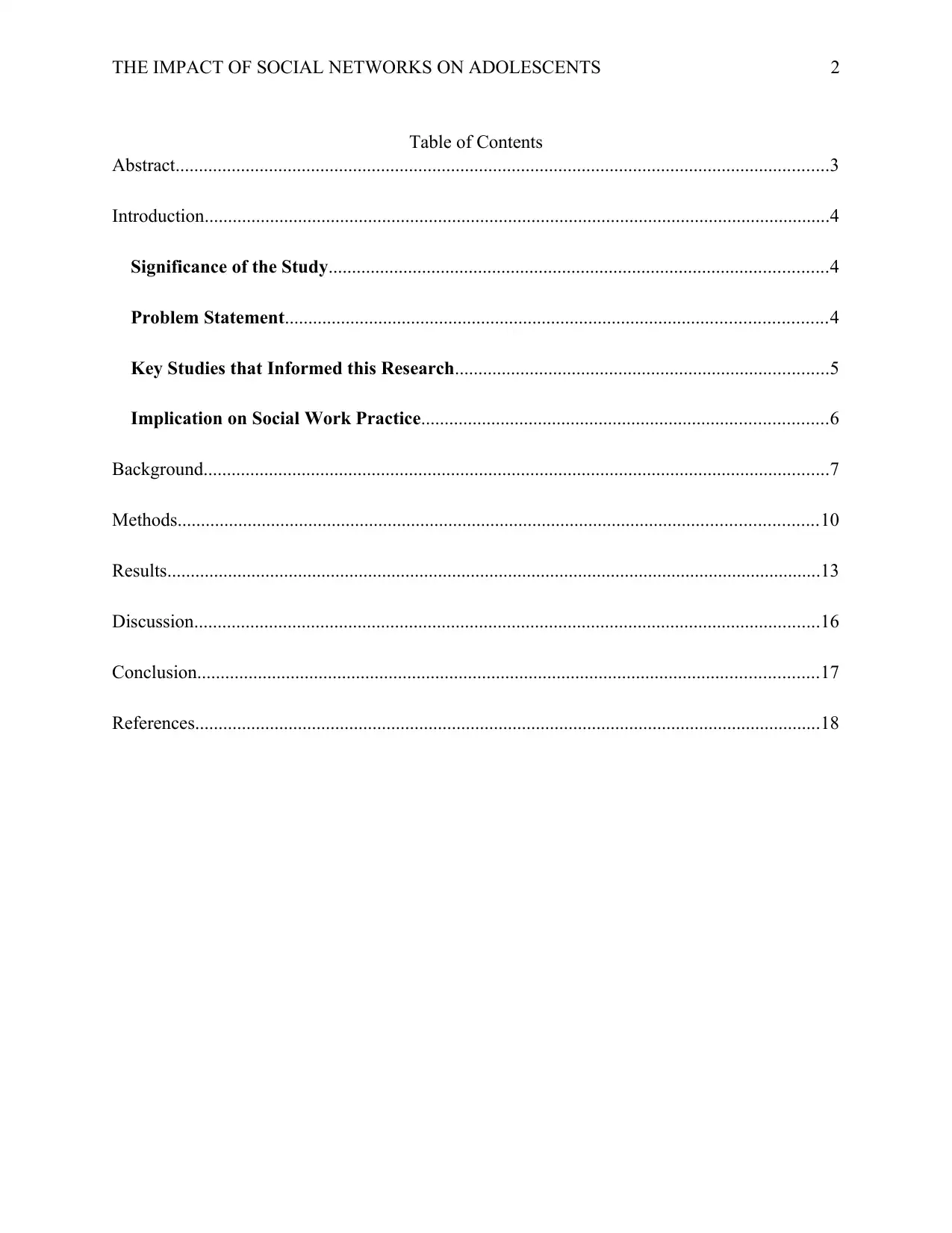
THE IMPACT OF SOCIAL NETWORKS ON ADOLESCENTS 2
Table of Contents
Abstract............................................................................................................................................3
Introduction......................................................................................................................................4
Significance of the Study...........................................................................................................4
Problem Statement....................................................................................................................4
Key Studies that Informed this Research................................................................................5
Implication on Social Work Practice.......................................................................................6
Background......................................................................................................................................7
Methods.........................................................................................................................................10
Results............................................................................................................................................13
Discussion......................................................................................................................................16
Conclusion.....................................................................................................................................17
References......................................................................................................................................18
Table of Contents
Abstract............................................................................................................................................3
Introduction......................................................................................................................................4
Significance of the Study...........................................................................................................4
Problem Statement....................................................................................................................4
Key Studies that Informed this Research................................................................................5
Implication on Social Work Practice.......................................................................................6
Background......................................................................................................................................7
Methods.........................................................................................................................................10
Results............................................................................................................................................13
Discussion......................................................................................................................................16
Conclusion.....................................................................................................................................17
References......................................................................................................................................18
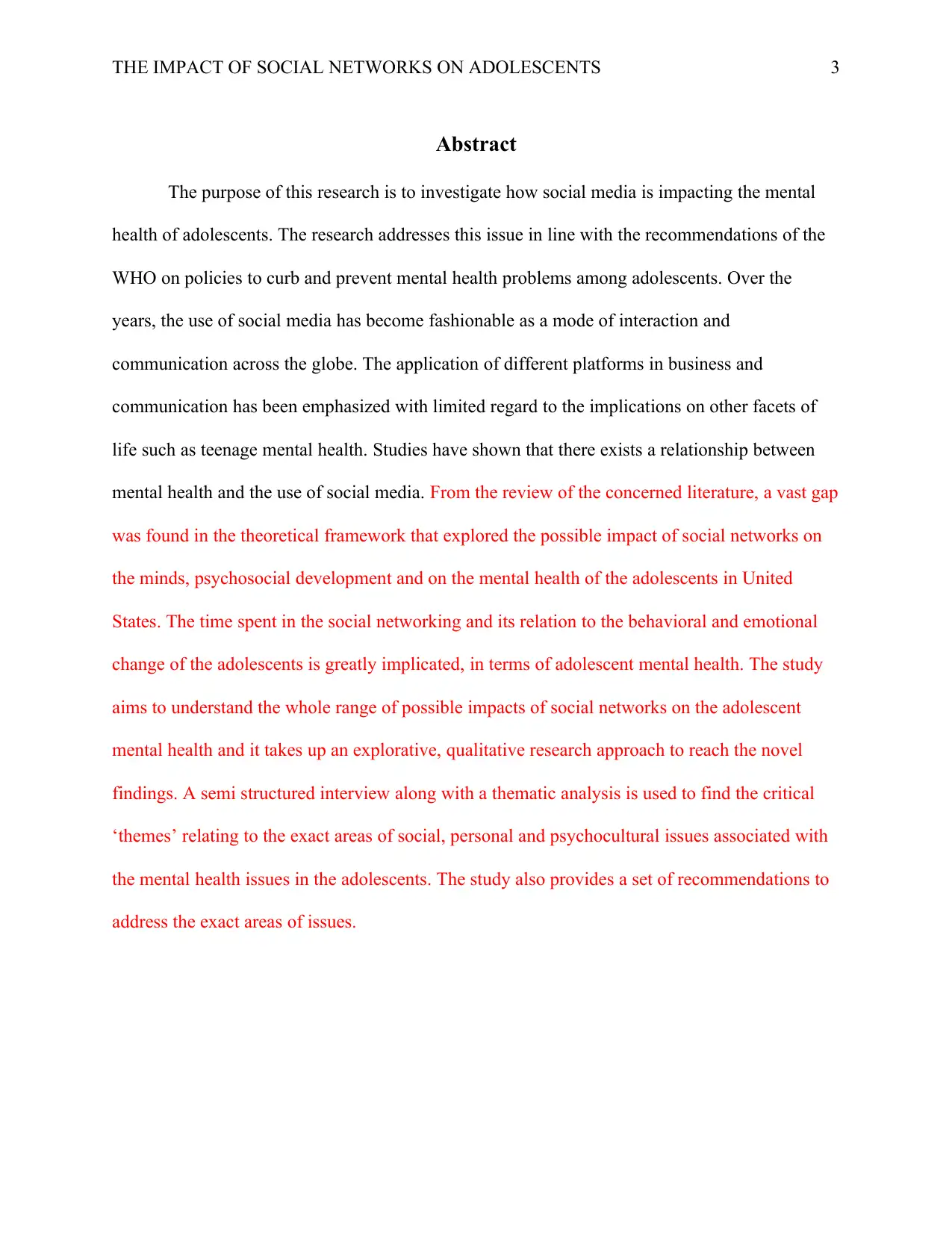
THE IMPACT OF SOCIAL NETWORKS ON ADOLESCENTS 3
Abstract
The purpose of this research is to investigate how social media is impacting the mental
health of adolescents. The research addresses this issue in line with the recommendations of the
WHO on policies to curb and prevent mental health problems among adolescents. Over the
years, the use of social media has become fashionable as a mode of interaction and
communication across the globe. The application of different platforms in business and
communication has been emphasized with limited regard to the implications on other facets of
life such as teenage mental health. Studies have shown that there exists a relationship between
mental health and the use of social media. From the review of the concerned literature, a vast gap
was found in the theoretical framework that explored the possible impact of social networks on
the minds, psychosocial development and on the mental health of the adolescents in United
States. The time spent in the social networking and its relation to the behavioral and emotional
change of the adolescents is greatly implicated, in terms of adolescent mental health. The study
aims to understand the whole range of possible impacts of social networks on the adolescent
mental health and it takes up an explorative, qualitative research approach to reach the novel
findings. A semi structured interview along with a thematic analysis is used to find the critical
‘themes’ relating to the exact areas of social, personal and psychocultural issues associated with
the mental health issues in the adolescents. The study also provides a set of recommendations to
address the exact areas of issues.
Abstract
The purpose of this research is to investigate how social media is impacting the mental
health of adolescents. The research addresses this issue in line with the recommendations of the
WHO on policies to curb and prevent mental health problems among adolescents. Over the
years, the use of social media has become fashionable as a mode of interaction and
communication across the globe. The application of different platforms in business and
communication has been emphasized with limited regard to the implications on other facets of
life such as teenage mental health. Studies have shown that there exists a relationship between
mental health and the use of social media. From the review of the concerned literature, a vast gap
was found in the theoretical framework that explored the possible impact of social networks on
the minds, psychosocial development and on the mental health of the adolescents in United
States. The time spent in the social networking and its relation to the behavioral and emotional
change of the adolescents is greatly implicated, in terms of adolescent mental health. The study
aims to understand the whole range of possible impacts of social networks on the adolescent
mental health and it takes up an explorative, qualitative research approach to reach the novel
findings. A semi structured interview along with a thematic analysis is used to find the critical
‘themes’ relating to the exact areas of social, personal and psychocultural issues associated with
the mental health issues in the adolescents. The study also provides a set of recommendations to
address the exact areas of issues.
⊘ This is a preview!⊘
Do you want full access?
Subscribe today to unlock all pages.

Trusted by 1+ million students worldwide

THE IMPACT OF SOCIAL NETWORKS ON ADOLESCENTS 4
The Impact of Social Networks on Adolescents
Introduction
Significance of the Study
The World Health Organization (WHO) requires each country to have robust and
multidimensional mental health policies for adolescents (WHO, 2005). The policy should
address key areas such as stigma and discrimination, mental disorders, risk factors, prevention,
and management. The government is expected to come up with sustainable intervention and
foster awareness across different populations and stakeholders by capitalizing on partnership and
collaboration. Studies seeking to investigate the problem of teenage mental health are essential
because they offer important insights, evidence, and recommendations that inform policy
development and implementation (Hetrick et al., 2016). Amid this era of digitalization and
sophisticated technology, social media has become one of the most common platforms for
interaction (O’Keeffe & Clarke-Pearson, 2011; Pew Research Centre, 2015). The number of
adolescents using social media in increasing each moment. However, this has equally
exacerbated the process of prevention and management of teenage mental health problems. This
study is targeting adolescents between the age of 10 and 16 since this group is at a high risk of
poor mental health. The study is significant because the findings and recommendations will be
used to inform policy decisions and changes to improve adolescent mental health and
management capacity across different institutions.
Problem Statement
It is estimated that over 10-20% of young children experience mental health challenges.
About 75% of the cases are witnessed between the age of 14 and 16. Common conditions include
anxiety and depression. At the same time, there has been an escalating trend in recent years
The Impact of Social Networks on Adolescents
Introduction
Significance of the Study
The World Health Organization (WHO) requires each country to have robust and
multidimensional mental health policies for adolescents (WHO, 2005). The policy should
address key areas such as stigma and discrimination, mental disorders, risk factors, prevention,
and management. The government is expected to come up with sustainable intervention and
foster awareness across different populations and stakeholders by capitalizing on partnership and
collaboration. Studies seeking to investigate the problem of teenage mental health are essential
because they offer important insights, evidence, and recommendations that inform policy
development and implementation (Hetrick et al., 2016). Amid this era of digitalization and
sophisticated technology, social media has become one of the most common platforms for
interaction (O’Keeffe & Clarke-Pearson, 2011; Pew Research Centre, 2015). The number of
adolescents using social media in increasing each moment. However, this has equally
exacerbated the process of prevention and management of teenage mental health problems. This
study is targeting adolescents between the age of 10 and 16 since this group is at a high risk of
poor mental health. The study is significant because the findings and recommendations will be
used to inform policy decisions and changes to improve adolescent mental health and
management capacity across different institutions.
Problem Statement
It is estimated that over 10-20% of young children experience mental health challenges.
About 75% of the cases are witnessed between the age of 14 and 16. Common conditions include
anxiety and depression. At the same time, there has been an escalating trend in recent years
Paraphrase This Document
Need a fresh take? Get an instant paraphrase of this document with our AI Paraphraser
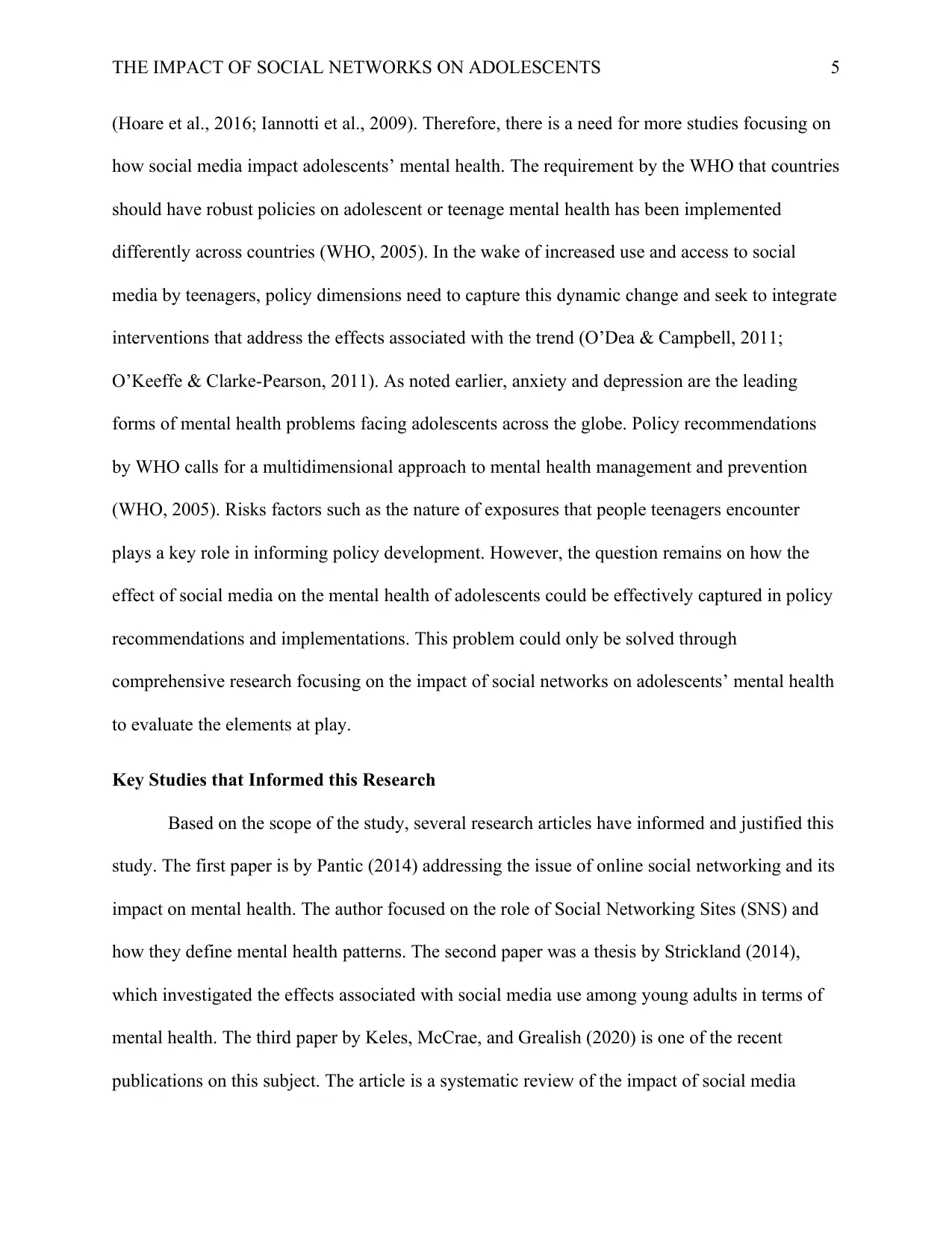
THE IMPACT OF SOCIAL NETWORKS ON ADOLESCENTS 5
(Hoare et al., 2016; Iannotti et al., 2009). Therefore, there is a need for more studies focusing on
how social media impact adolescents’ mental health. The requirement by the WHO that countries
should have robust policies on adolescent or teenage mental health has been implemented
differently across countries (WHO, 2005). In the wake of increased use and access to social
media by teenagers, policy dimensions need to capture this dynamic change and seek to integrate
interventions that address the effects associated with the trend (O’Dea & Campbell, 2011;
O’Keeffe & Clarke-Pearson, 2011). As noted earlier, anxiety and depression are the leading
forms of mental health problems facing adolescents across the globe. Policy recommendations
by WHO calls for a multidimensional approach to mental health management and prevention
(WHO, 2005). Risks factors such as the nature of exposures that people teenagers encounter
plays a key role in informing policy development. However, the question remains on how the
effect of social media on the mental health of adolescents could be effectively captured in policy
recommendations and implementations. This problem could only be solved through
comprehensive research focusing on the impact of social networks on adolescents’ mental health
to evaluate the elements at play.
Key Studies that Informed this Research
Based on the scope of the study, several research articles have informed and justified this
study. The first paper is by Pantic (2014) addressing the issue of online social networking and its
impact on mental health. The author focused on the role of Social Networking Sites (SNS) and
how they define mental health patterns. The second paper was a thesis by Strickland (2014),
which investigated the effects associated with social media use among young adults in terms of
mental health. The third paper by Keles, McCrae, and Grealish (2020) is one of the recent
publications on this subject. The article is a systematic review of the impact of social media
(Hoare et al., 2016; Iannotti et al., 2009). Therefore, there is a need for more studies focusing on
how social media impact adolescents’ mental health. The requirement by the WHO that countries
should have robust policies on adolescent or teenage mental health has been implemented
differently across countries (WHO, 2005). In the wake of increased use and access to social
media by teenagers, policy dimensions need to capture this dynamic change and seek to integrate
interventions that address the effects associated with the trend (O’Dea & Campbell, 2011;
O’Keeffe & Clarke-Pearson, 2011). As noted earlier, anxiety and depression are the leading
forms of mental health problems facing adolescents across the globe. Policy recommendations
by WHO calls for a multidimensional approach to mental health management and prevention
(WHO, 2005). Risks factors such as the nature of exposures that people teenagers encounter
plays a key role in informing policy development. However, the question remains on how the
effect of social media on the mental health of adolescents could be effectively captured in policy
recommendations and implementations. This problem could only be solved through
comprehensive research focusing on the impact of social networks on adolescents’ mental health
to evaluate the elements at play.
Key Studies that Informed this Research
Based on the scope of the study, several research articles have informed and justified this
study. The first paper is by Pantic (2014) addressing the issue of online social networking and its
impact on mental health. The author focused on the role of Social Networking Sites (SNS) and
how they define mental health patterns. The second paper was a thesis by Strickland (2014),
which investigated the effects associated with social media use among young adults in terms of
mental health. The third paper by Keles, McCrae, and Grealish (2020) is one of the recent
publications on this subject. The article is a systematic review of the impact of social media
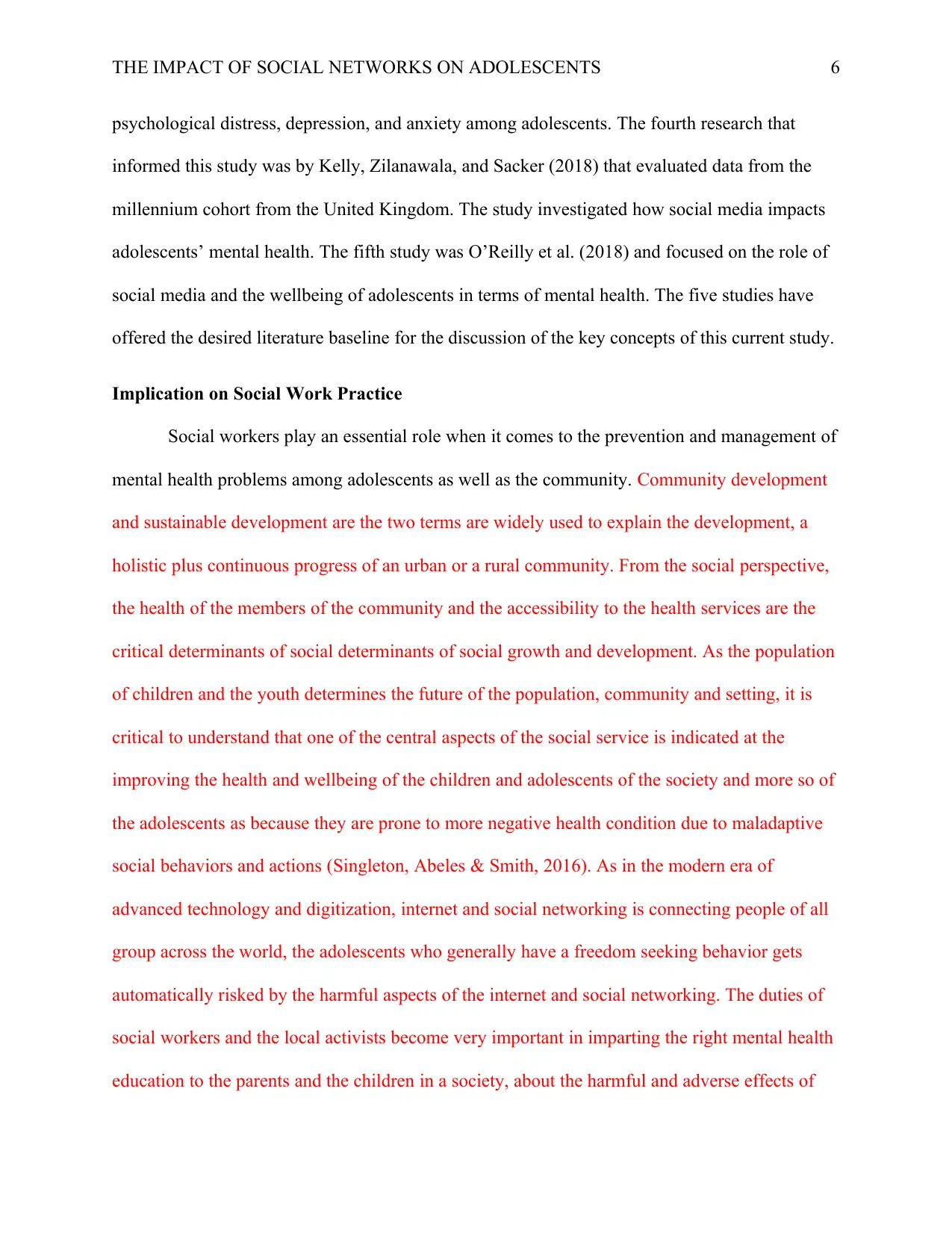
THE IMPACT OF SOCIAL NETWORKS ON ADOLESCENTS 6
psychological distress, depression, and anxiety among adolescents. The fourth research that
informed this study was by Kelly, Zilanawala, and Sacker (2018) that evaluated data from the
millennium cohort from the United Kingdom. The study investigated how social media impacts
adolescents’ mental health. The fifth study was O’Reilly et al. (2018) and focused on the role of
social media and the wellbeing of adolescents in terms of mental health. The five studies have
offered the desired literature baseline for the discussion of the key concepts of this current study.
Implication on Social Work Practice
Social workers play an essential role when it comes to the prevention and management of
mental health problems among adolescents as well as the community. Community development
and sustainable development are the two terms are widely used to explain the development, a
holistic plus continuous progress of an urban or a rural community. From the social perspective,
the health of the members of the community and the accessibility to the health services are the
critical determinants of social determinants of social growth and development. As the population
of children and the youth determines the future of the population, community and setting, it is
critical to understand that one of the central aspects of the social service is indicated at the
improving the health and wellbeing of the children and adolescents of the society and more so of
the adolescents as because they are prone to more negative health condition due to maladaptive
social behaviors and actions (Singleton, Abeles & Smith, 2016). As in the modern era of
advanced technology and digitization, internet and social networking is connecting people of all
group across the world, the adolescents who generally have a freedom seeking behavior gets
automatically risked by the harmful aspects of the internet and social networking. The duties of
social workers and the local activists become very important in imparting the right mental health
education to the parents and the children in a society, about the harmful and adverse effects of
psychological distress, depression, and anxiety among adolescents. The fourth research that
informed this study was by Kelly, Zilanawala, and Sacker (2018) that evaluated data from the
millennium cohort from the United Kingdom. The study investigated how social media impacts
adolescents’ mental health. The fifth study was O’Reilly et al. (2018) and focused on the role of
social media and the wellbeing of adolescents in terms of mental health. The five studies have
offered the desired literature baseline for the discussion of the key concepts of this current study.
Implication on Social Work Practice
Social workers play an essential role when it comes to the prevention and management of
mental health problems among adolescents as well as the community. Community development
and sustainable development are the two terms are widely used to explain the development, a
holistic plus continuous progress of an urban or a rural community. From the social perspective,
the health of the members of the community and the accessibility to the health services are the
critical determinants of social determinants of social growth and development. As the population
of children and the youth determines the future of the population, community and setting, it is
critical to understand that one of the central aspects of the social service is indicated at the
improving the health and wellbeing of the children and adolescents of the society and more so of
the adolescents as because they are prone to more negative health condition due to maladaptive
social behaviors and actions (Singleton, Abeles & Smith, 2016). As in the modern era of
advanced technology and digitization, internet and social networking is connecting people of all
group across the world, the adolescents who generally have a freedom seeking behavior gets
automatically risked by the harmful aspects of the internet and social networking. The duties of
social workers and the local activists become very important in imparting the right mental health
education to the parents and the children in a society, about the harmful and adverse effects of
⊘ This is a preview!⊘
Do you want full access?
Subscribe today to unlock all pages.

Trusted by 1+ million students worldwide
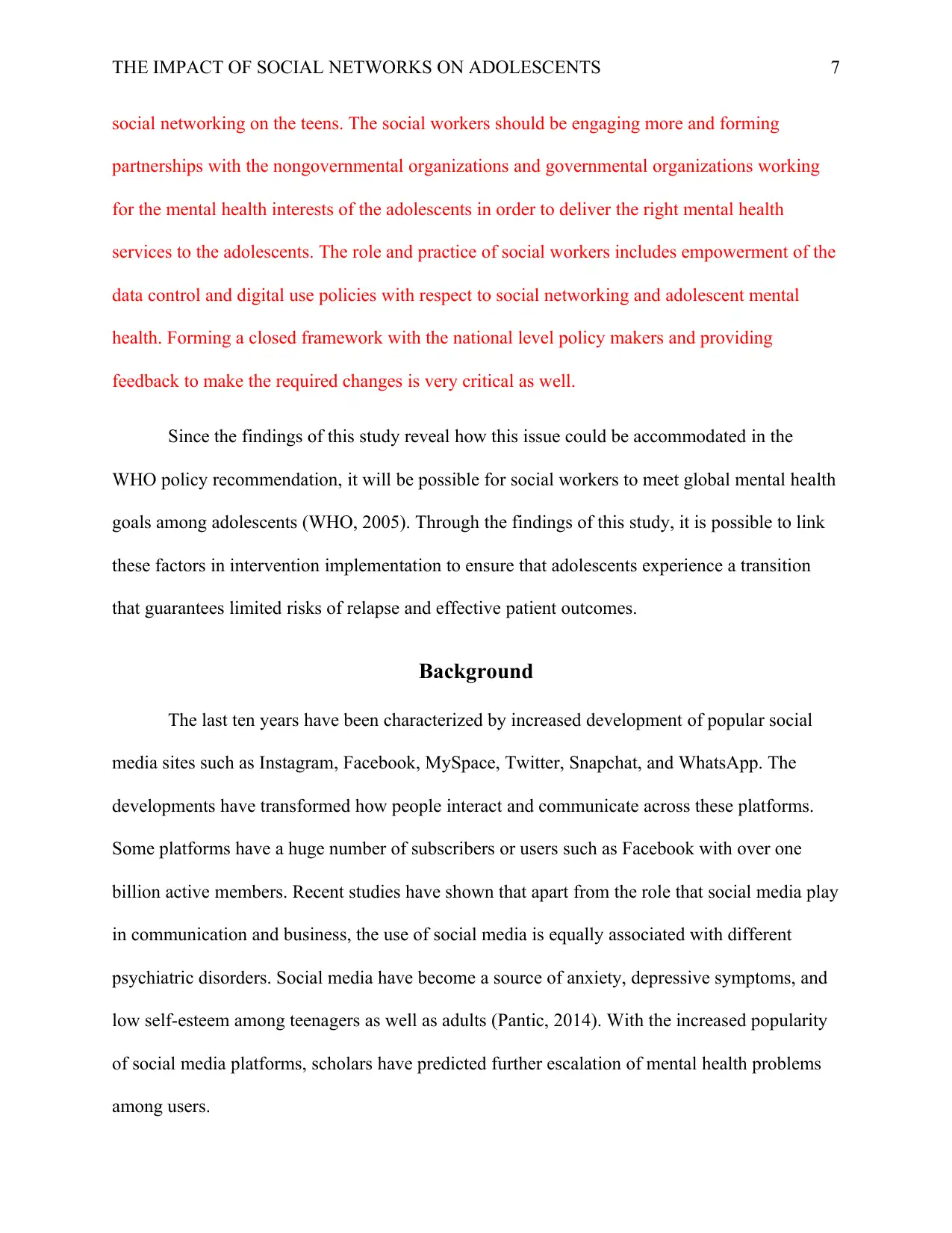
THE IMPACT OF SOCIAL NETWORKS ON ADOLESCENTS 7
social networking on the teens. The social workers should be engaging more and forming
partnerships with the nongovernmental organizations and governmental organizations working
for the mental health interests of the adolescents in order to deliver the right mental health
services to the adolescents. The role and practice of social workers includes empowerment of the
data control and digital use policies with respect to social networking and adolescent mental
health. Forming a closed framework with the national level policy makers and providing
feedback to make the required changes is very critical as well.
Since the findings of this study reveal how this issue could be accommodated in the
WHO policy recommendation, it will be possible for social workers to meet global mental health
goals among adolescents (WHO, 2005). Through the findings of this study, it is possible to link
these factors in intervention implementation to ensure that adolescents experience a transition
that guarantees limited risks of relapse and effective patient outcomes.
Background
The last ten years have been characterized by increased development of popular social
media sites such as Instagram, Facebook, MySpace, Twitter, Snapchat, and WhatsApp. The
developments have transformed how people interact and communicate across these platforms.
Some platforms have a huge number of subscribers or users such as Facebook with over one
billion active members. Recent studies have shown that apart from the role that social media play
in communication and business, the use of social media is equally associated with different
psychiatric disorders. Social media have become a source of anxiety, depressive symptoms, and
low self-esteem among teenagers as well as adults (Pantic, 2014). With the increased popularity
of social media platforms, scholars have predicted further escalation of mental health problems
among users.
social networking on the teens. The social workers should be engaging more and forming
partnerships with the nongovernmental organizations and governmental organizations working
for the mental health interests of the adolescents in order to deliver the right mental health
services to the adolescents. The role and practice of social workers includes empowerment of the
data control and digital use policies with respect to social networking and adolescent mental
health. Forming a closed framework with the national level policy makers and providing
feedback to make the required changes is very critical as well.
Since the findings of this study reveal how this issue could be accommodated in the
WHO policy recommendation, it will be possible for social workers to meet global mental health
goals among adolescents (WHO, 2005). Through the findings of this study, it is possible to link
these factors in intervention implementation to ensure that adolescents experience a transition
that guarantees limited risks of relapse and effective patient outcomes.
Background
The last ten years have been characterized by increased development of popular social
media sites such as Instagram, Facebook, MySpace, Twitter, Snapchat, and WhatsApp. The
developments have transformed how people interact and communicate across these platforms.
Some platforms have a huge number of subscribers or users such as Facebook with over one
billion active members. Recent studies have shown that apart from the role that social media play
in communication and business, the use of social media is equally associated with different
psychiatric disorders. Social media have become a source of anxiety, depressive symptoms, and
low self-esteem among teenagers as well as adults (Pantic, 2014). With the increased popularity
of social media platforms, scholars have predicted further escalation of mental health problems
among users.
Paraphrase This Document
Need a fresh take? Get an instant paraphrase of this document with our AI Paraphraser

THE IMPACT OF SOCIAL NETWORKS ON ADOLESCENTS 8
Healthcare organizations have been keen to recommend the implementation of policy
initiatives to curb mental health problems. However, with the new dimensions emerging such as
the impact of social media platforms on people’s mental health, there has been a lack of a holistic
approach to the mitigation processes. For example, the limited knowledge of how mental health
is affected by social media interactions is not captured in the national policy frameworks across
different countries. Such a limitation has become an obstacle to the comprehensive
implementation of intervention programs. The efforts of social workers have been thwarted by
the lack of adequate awareness among the targeted population and stakeholders within the care
environment regarding this issue. There is an increased lack of knowledge, awareness about the
different conditions that affect mental health and wellbeing of the adolescents and lack of self -
care skills as well parenting skills are greatly involved in the development of mental health
conditions amongst the adolescents in the community, resulting from wrong use of information
technology such as the concept of social networking. The idea of social networking appeals as
exciting to the older children and there is a positive perception in the adolescents even about the
negative sides of the social networking and here is where the lack of awareness and good
judgment to be taken about one’s health and wellbeing comes to play (Baker, & Algorta, 2016).
The parental support and the social support in the prevention of the mental health issues and in
the management of the mental health issues when already is affected by various internal and
external factors again. Lack of knowledge about the mental health policies and internet usage
policies and even the very lack of essential policies and regulations in the management of the
adolescent mental health issues arising from the social networking – are critical barriers to health
and social change. The researches done in this area is also very limited and the biopsychosoical
Healthcare organizations have been keen to recommend the implementation of policy
initiatives to curb mental health problems. However, with the new dimensions emerging such as
the impact of social media platforms on people’s mental health, there has been a lack of a holistic
approach to the mitigation processes. For example, the limited knowledge of how mental health
is affected by social media interactions is not captured in the national policy frameworks across
different countries. Such a limitation has become an obstacle to the comprehensive
implementation of intervention programs. The efforts of social workers have been thwarted by
the lack of adequate awareness among the targeted population and stakeholders within the care
environment regarding this issue. There is an increased lack of knowledge, awareness about the
different conditions that affect mental health and wellbeing of the adolescents and lack of self -
care skills as well parenting skills are greatly involved in the development of mental health
conditions amongst the adolescents in the community, resulting from wrong use of information
technology such as the concept of social networking. The idea of social networking appeals as
exciting to the older children and there is a positive perception in the adolescents even about the
negative sides of the social networking and here is where the lack of awareness and good
judgment to be taken about one’s health and wellbeing comes to play (Baker, & Algorta, 2016).
The parental support and the social support in the prevention of the mental health issues and in
the management of the mental health issues when already is affected by various internal and
external factors again. Lack of knowledge about the mental health policies and internet usage
policies and even the very lack of essential policies and regulations in the management of the
adolescent mental health issues arising from the social networking – are critical barriers to health
and social change. The researches done in this area is also very limited and the biopsychosoical

THE IMPACT OF SOCIAL NETWORKS ON ADOLESCENTS 9
elements related to research problem, is not taken into consideration for policy change, which is
hugely problematic.
According to Strickland (2014), young adults, especially adolescents, form the highest
representation on social media platforms. A huge percentage of active users and teenagers. The
nature of information shared across these platforms and the manner of peer-to-peer interaction
creates an enabling environment for the propagation of anxiety and depressive tendencies among
adolescents. Young teenagers who are constantly active on social media are at a higher risk of
developing mental health complications when compared to those who spend their lives outside
social media platforms (Strickland, 2014).
According to Keles, McCrae, and Grealish (2020), depression, psychological distress,
and anxiety cases have increased among adolescents owing to the high degree of engagement on
social media platforms. From the literature review carried by scholars, it was evident that policy
dimensions need to incorporate the effect of social media when designing intervention
frameworks to curb mental health issues among adolescents. According to Keles, McCrae, and
Grealish (2020), there is a need for more studies in this area for professionals to understand the
putative implications of social media among adolescents as they cope with mental health
problems and risks.
Kelly et al., (2018) found out that when the variable of gender is incorporated into the
analysis, girls were more vulnerable to the impact of social media on psychiatric disorders than
boys. However, the effect of the use of social media platforms was evident among adolescents
irrespective of gender variability. Evidence from Kelly et al. (2018) is not captured in policy
recommendations, which implies that there is a need for transformation of approach to mental
health management among adolescents. Indirect interrelation depicted in this article also paved
elements related to research problem, is not taken into consideration for policy change, which is
hugely problematic.
According to Strickland (2014), young adults, especially adolescents, form the highest
representation on social media platforms. A huge percentage of active users and teenagers. The
nature of information shared across these platforms and the manner of peer-to-peer interaction
creates an enabling environment for the propagation of anxiety and depressive tendencies among
adolescents. Young teenagers who are constantly active on social media are at a higher risk of
developing mental health complications when compared to those who spend their lives outside
social media platforms (Strickland, 2014).
According to Keles, McCrae, and Grealish (2020), depression, psychological distress,
and anxiety cases have increased among adolescents owing to the high degree of engagement on
social media platforms. From the literature review carried by scholars, it was evident that policy
dimensions need to incorporate the effect of social media when designing intervention
frameworks to curb mental health issues among adolescents. According to Keles, McCrae, and
Grealish (2020), there is a need for more studies in this area for professionals to understand the
putative implications of social media among adolescents as they cope with mental health
problems and risks.
Kelly et al., (2018) found out that when the variable of gender is incorporated into the
analysis, girls were more vulnerable to the impact of social media on psychiatric disorders than
boys. However, the effect of the use of social media platforms was evident among adolescents
irrespective of gender variability. Evidence from Kelly et al. (2018) is not captured in policy
recommendations, which implies that there is a need for transformation of approach to mental
health management among adolescents. Indirect interrelation depicted in this article also paved
⊘ This is a preview!⊘
Do you want full access?
Subscribe today to unlock all pages.

Trusted by 1+ million students worldwide
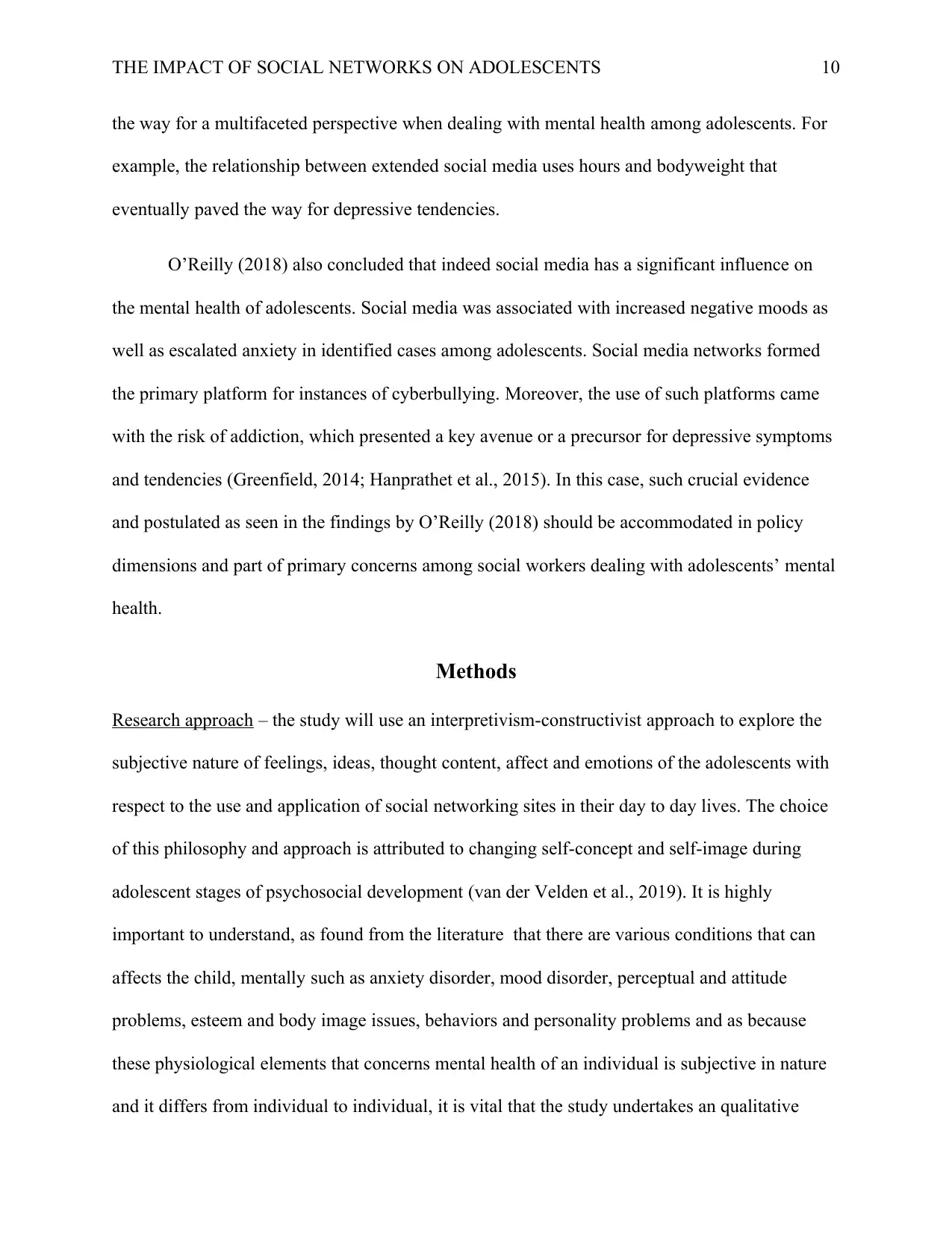
THE IMPACT OF SOCIAL NETWORKS ON ADOLESCENTS 10
the way for a multifaceted perspective when dealing with mental health among adolescents. For
example, the relationship between extended social media uses hours and bodyweight that
eventually paved the way for depressive tendencies.
O’Reilly (2018) also concluded that indeed social media has a significant influence on
the mental health of adolescents. Social media was associated with increased negative moods as
well as escalated anxiety in identified cases among adolescents. Social media networks formed
the primary platform for instances of cyberbullying. Moreover, the use of such platforms came
with the risk of addiction, which presented a key avenue or a precursor for depressive symptoms
and tendencies (Greenfield, 2014; Hanprathet et al., 2015). In this case, such crucial evidence
and postulated as seen in the findings by O’Reilly (2018) should be accommodated in policy
dimensions and part of primary concerns among social workers dealing with adolescents’ mental
health.
Methods
Research approach – the study will use an interpretivism-constructivist approach to explore the
subjective nature of feelings, ideas, thought content, affect and emotions of the adolescents with
respect to the use and application of social networking sites in their day to day lives. The choice
of this philosophy and approach is attributed to changing self-concept and self-image during
adolescent stages of psychosocial development (van der Velden et al., 2019). It is highly
important to understand, as found from the literature that there are various conditions that can
affects the child, mentally such as anxiety disorder, mood disorder, perceptual and attitude
problems, esteem and body image issues, behaviors and personality problems and as because
these physiological elements that concerns mental health of an individual is subjective in nature
and it differs from individual to individual, it is vital that the study undertakes an qualitative
the way for a multifaceted perspective when dealing with mental health among adolescents. For
example, the relationship between extended social media uses hours and bodyweight that
eventually paved the way for depressive tendencies.
O’Reilly (2018) also concluded that indeed social media has a significant influence on
the mental health of adolescents. Social media was associated with increased negative moods as
well as escalated anxiety in identified cases among adolescents. Social media networks formed
the primary platform for instances of cyberbullying. Moreover, the use of such platforms came
with the risk of addiction, which presented a key avenue or a precursor for depressive symptoms
and tendencies (Greenfield, 2014; Hanprathet et al., 2015). In this case, such crucial evidence
and postulated as seen in the findings by O’Reilly (2018) should be accommodated in policy
dimensions and part of primary concerns among social workers dealing with adolescents’ mental
health.
Methods
Research approach – the study will use an interpretivism-constructivist approach to explore the
subjective nature of feelings, ideas, thought content, affect and emotions of the adolescents with
respect to the use and application of social networking sites in their day to day lives. The choice
of this philosophy and approach is attributed to changing self-concept and self-image during
adolescent stages of psychosocial development (van der Velden et al., 2019). It is highly
important to understand, as found from the literature that there are various conditions that can
affects the child, mentally such as anxiety disorder, mood disorder, perceptual and attitude
problems, esteem and body image issues, behaviors and personality problems and as because
these physiological elements that concerns mental health of an individual is subjective in nature
and it differs from individual to individual, it is vital that the study undertakes an qualitative
Paraphrase This Document
Need a fresh take? Get an instant paraphrase of this document with our AI Paraphraser
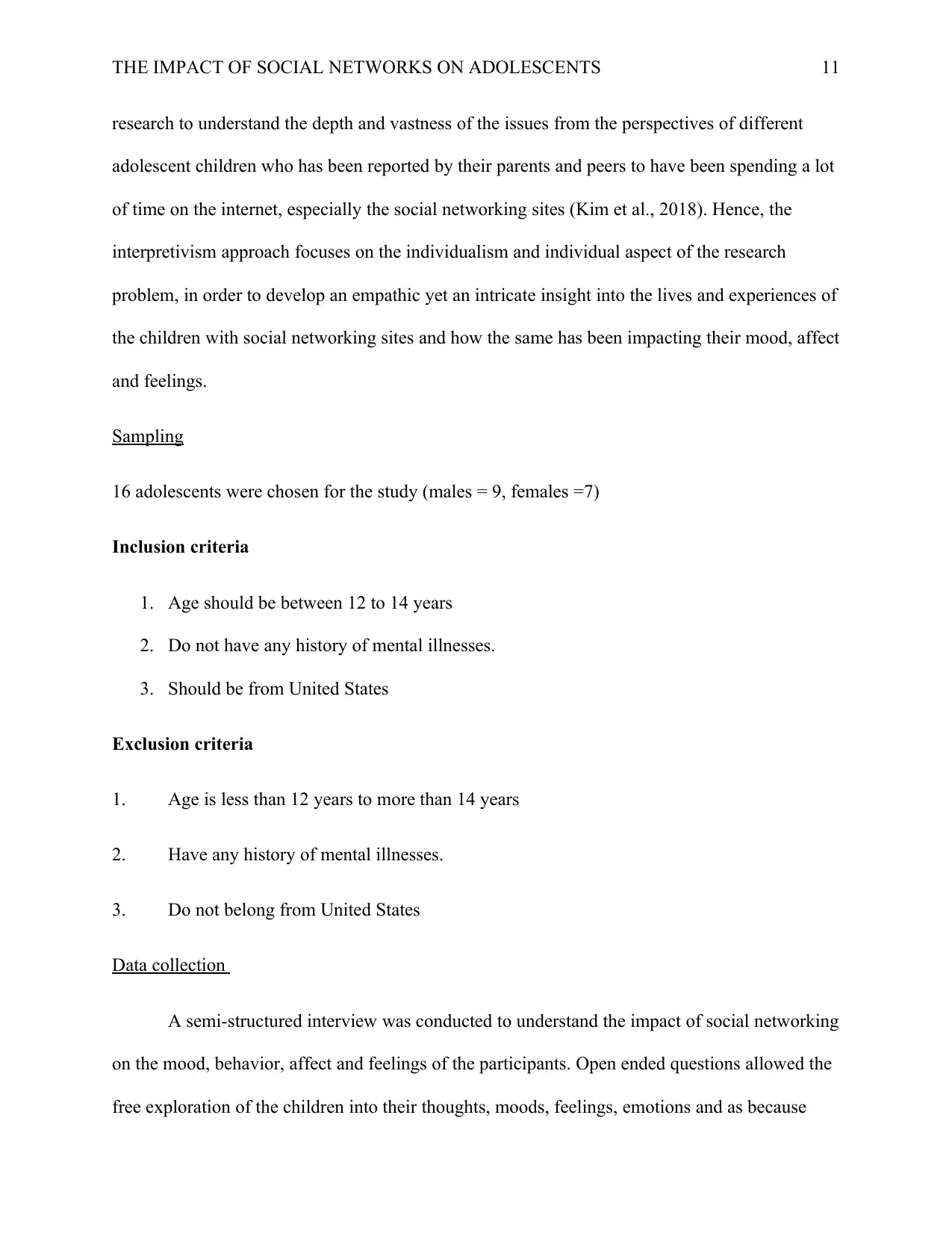
THE IMPACT OF SOCIAL NETWORKS ON ADOLESCENTS 11
research to understand the depth and vastness of the issues from the perspectives of different
adolescent children who has been reported by their parents and peers to have been spending a lot
of time on the internet, especially the social networking sites (Kim et al., 2018). Hence, the
interpretivism approach focuses on the individualism and individual aspect of the research
problem, in order to develop an empathic yet an intricate insight into the lives and experiences of
the children with social networking sites and how the same has been impacting their mood, affect
and feelings.
Sampling
16 adolescents were chosen for the study (males = 9, females =7)
Inclusion criteria
1. Age should be between 12 to 14 years
2. Do not have any history of mental illnesses.
3. Should be from United States
Exclusion criteria
1. Age is less than 12 years to more than 14 years
2. Have any history of mental illnesses.
3. Do not belong from United States
Data collection
A semi-structured interview was conducted to understand the impact of social networking
on the mood, behavior, affect and feelings of the participants. Open ended questions allowed the
free exploration of the children into their thoughts, moods, feelings, emotions and as because
research to understand the depth and vastness of the issues from the perspectives of different
adolescent children who has been reported by their parents and peers to have been spending a lot
of time on the internet, especially the social networking sites (Kim et al., 2018). Hence, the
interpretivism approach focuses on the individualism and individual aspect of the research
problem, in order to develop an empathic yet an intricate insight into the lives and experiences of
the children with social networking sites and how the same has been impacting their mood, affect
and feelings.
Sampling
16 adolescents were chosen for the study (males = 9, females =7)
Inclusion criteria
1. Age should be between 12 to 14 years
2. Do not have any history of mental illnesses.
3. Should be from United States
Exclusion criteria
1. Age is less than 12 years to more than 14 years
2. Have any history of mental illnesses.
3. Do not belong from United States
Data collection
A semi-structured interview was conducted to understand the impact of social networking
on the mood, behavior, affect and feelings of the participants. Open ended questions allowed the
free exploration of the children into their thoughts, moods, feelings, emotions and as because

THE IMPACT OF SOCIAL NETWORKS ON ADOLESCENTS 12
children are less likely to organize their thoughts and relate to just a ‘yes’ or ‘no’, a semi
structured interview is best suited and provide a good opportunity to the adolescents for a
broader reflection on their own views and emotional, cognitive and affective parameters.
Ethical considerations
Informed consent – as the participants were in the minor age, the informed consent was taken
from the parents of the children, who bought their child to the research settings.
Equity – the resources of the article was equally distributed among the participants and there was
no demonstration of bias or discrimination from any of the researchers of the study.
Beneficence – the researcher made recommendations at the end of the study to the children and
to the parents of the children on how to balance between studies with limited use of social
networking and taught a constructive use of social networking, eliminating the harmful aspects
of it (Li et al., 2018).
Non-maleficence – every safety precaution and safety guidelines were followed to impart a sense
of psychological safety to the participants of the research and strict steps were taken to eliminate
any least chance of harm being done to the participants. Effective communication with warm
gestures to make the children feel comfortable at every point of time, during the interviewing
process was assured.
Privacy and confidentiality – each step was taken to ensure privacy of the children and the data
related to their identity, background, family situation and all the other form of personal data
provided was kept confidential.
children are less likely to organize their thoughts and relate to just a ‘yes’ or ‘no’, a semi
structured interview is best suited and provide a good opportunity to the adolescents for a
broader reflection on their own views and emotional, cognitive and affective parameters.
Ethical considerations
Informed consent – as the participants were in the minor age, the informed consent was taken
from the parents of the children, who bought their child to the research settings.
Equity – the resources of the article was equally distributed among the participants and there was
no demonstration of bias or discrimination from any of the researchers of the study.
Beneficence – the researcher made recommendations at the end of the study to the children and
to the parents of the children on how to balance between studies with limited use of social
networking and taught a constructive use of social networking, eliminating the harmful aspects
of it (Li et al., 2018).
Non-maleficence – every safety precaution and safety guidelines were followed to impart a sense
of psychological safety to the participants of the research and strict steps were taken to eliminate
any least chance of harm being done to the participants. Effective communication with warm
gestures to make the children feel comfortable at every point of time, during the interviewing
process was assured.
Privacy and confidentiality – each step was taken to ensure privacy of the children and the data
related to their identity, background, family situation and all the other form of personal data
provided was kept confidential.
⊘ This is a preview!⊘
Do you want full access?
Subscribe today to unlock all pages.

Trusted by 1+ million students worldwide
1 out of 23
Related Documents
Your All-in-One AI-Powered Toolkit for Academic Success.
+13062052269
info@desklib.com
Available 24*7 on WhatsApp / Email
![[object Object]](/_next/static/media/star-bottom.7253800d.svg)
Unlock your academic potential
Copyright © 2020–2026 A2Z Services. All Rights Reserved. Developed and managed by ZUCOL.




